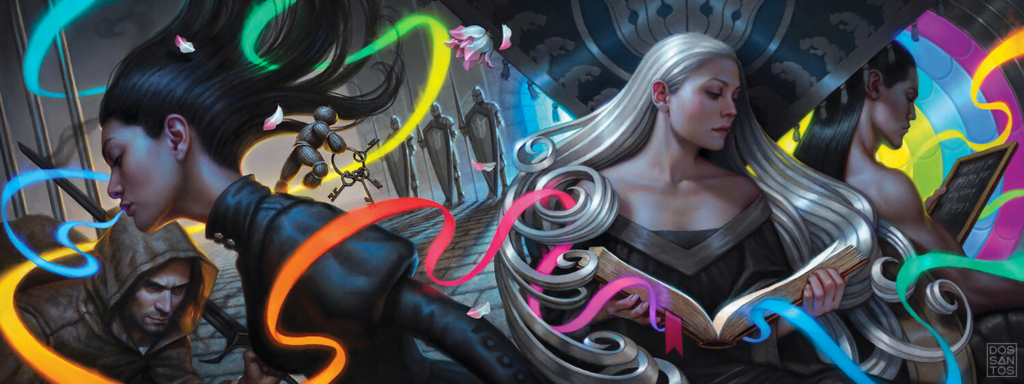If you spend some time on the internet or around a table of DMs, invariably, the subject of alignment will arise. A tool of the earliest versions of the game, the idea of alignment seems to provide an easy way to encapsulate the PCs’ attitudes about the world and each other and create a clear dichotomy between the PCs and their enemies. DnD alignments: Good vs. Evil, Laws vs. Chaos, easy. It doesn’t take much to see this “easy” solution fall over, however. In this article, I would like to explore the possibilities available behind the idea of alignment and a simple implementation change that can bring new life into this old standby.

Alignment, A Thing About Lines?
So, quick intro to alignment as a principle. What alignment describes is the dichotomy of values across different peoples in a universal way. It has two default dimensions: Law vs. Chaos, Good vs. Evil, and an implied axiom of being “centrist” or Neutral. Three positions along two axes result in nine total options. This is uniquely different from the political opinion graph, also split along two axes where the middle ground is implied to be a shared space.
The Limits of Classical Alignment
As you can probably tell classical alignment definitions run into problems pretty quickly in modern roleplaying games and will often find the concept replaced with ideals, flaws and bonds or some other narrative mechanic. The important characteristic here is that while the original axiom is great for telling stories about good vs. evil or society vs nature, it doesn’t port well to narratives where none of those ideas match the central conflict.
South Central Conflict
The central conflict, I’ve heard of that! People who talk on the internet talk about this subject all the time! The reason a central conflict is necessary to a compelling story should not need a bunch of explanation. It is basically why your players’ characters are engaged in the adventure—the big picture of what they are doing in the world. At the end of the day, the player characters will align with one side of the central conflict. The other side is the realm of the enemy, the bad buy, the villain. So what makes a good central conflict?
The short answer, values. What do people in your world value? Who wants to steal, diminish, or destroy it? So let’s imagine the party finds themselves in a run-down hamlet over-taxed by the local lord. A small band of thieves has hatched a plan to break into the lord’s keep and off with “somodat fine silva knobs n’ such.” A buyer has been lined up to fence it, and they hire the party to infiltrate. “Won do nah good for un of uz locals to get caught! Weya delegatin!”
Stealing in the Name of…
Now what the party is about to engage in is a crime. Classically a chaotic evil act: BUT, because of the context, a totally legitimate way to clip the royal purse and put some money back in the hands of the people. So what is the central conflict in this adventure? Let’s say loyalists (those faithfully serving the lords will). This includes most guards, the tax collector, and a housecarl and his soldiers. The opposition is the poor, the oppressed. We will call them the resistance. So our first axis is loyalist/resistance.
Next, what are the methods? Well, Dugan, the rogue, is known to slit some throats. Not exactly a non-violence advocate. Malina, the wizard, on the other hand, is just down on her luck and needs to scrape up some money for spell components. They aren’t really into violence but know how to defend themselves. So we say pacifist/murderous is the other axis. And neutral goes in the middle?
Aha, now we see the brilliance of the design. We can actually hide narrative in our middle slots. The middle of loyalists/resistance isn’t an innocent bystander who doesn’t care! Maybe the character is rich and only in it for the rush of burglary, a real professional type. So disinterested in our central conflict, but they are a thrill seeker on the other axis, not particularly violent but willing to take risks for the adrenaline (disinterested thrillseeker). Or perhaps the local priest has joined in the heist to reclaim unfairly taxed tithe, money that was supposed to go to the poor! Pacifist resistance, maybe? or perhaps they waffle under pressure, so their alignment is pacifist cowardly!
That Sounds Hard!
Small price to pay for having narrative tools at your players’ disposal. And the best part is: When the central conflict changes, because the characters change or their perspective changes, you need to ask them how their character sits with the new central tension and the new circumstances! Hell, you could introduce a new set of axes for each adventure and have the players choose a side or an excuse. The resulting list would literally describe the complexities of the character so much more fully than CN. Someone who may be pacifist/cowardly when robbing from the regional lord may be loyalist/murderous when defending the orphanage from roving orcs! All you need to do as the DM is write down your central tension as opposing sides putting the bad guys on one and tell the party to pick a side or pick a reason. As long as they are willing to be on board or an excuse for being neutral, you are good to go with a party that will work together to achieve a common goal. And they can still argue about murdering the informant (looking at you, paladin and rogue!).
